History
The Occidental Life Building was built in 1917 as the new headquarters of the Occidental Life Insurance Company, which had been organized in 1906 by a group of prominent local businessmen. [5] The building was designed by Henry C. Trost, the chief architect of the El Paso firm of Trost & Trost. [3] Trost was a prolific designer whose other built works in Albuquerque include the Rosenwald Building, First National Bank Building, and Sunshine Building. The building's unusual Venetian Gothic design was reportedly suggested by Occidental Life vice president George Roslington, a native of England. [5]
The building opened to the public with an evening ceremony on August 1, 1917, which was attended by an estimated 1,000 people. In recognition of the American entry into World War I that year, the program included performances of Rule, Britannia! , The Maple Leaf Forever , and La Marseillaise . The building's early tenants included a number of other insurance agencies in addition to Occidental Life, as well as savings and loan companies, realtors, and an engineering firm. [5]
A fire broke out in the Occidental Life Building early on the morning of April 25, 1933, causing an estimated $100,000 in damage before firefighters managed to extinguish it around noon that day. [6] The building was mostly gutted, though the exterior walls remained intact up to the roofline. [5] The Albuquerque Journal reported that the fire was thought to have started "between the ceiling and the roof in the northeast corner of the building". The fire occurred just hours after the burning of another Albuquerque landmark, the Fourth Ward School (replaced the following year by Lew Wallace Elementary), leading police and local residents to suspect arson. [6]
Following the fire, the building was rebuilt to the design of W. Miles Brittelle of the Albuquerque firm of Brittelle and Ginner, reopening in the spring of 1934. In keeping with the building's Venetian influence, Brittelle decided to redesign the roofline to more closely resemble the Doge's Palace, with an ornamental frieze and finials in place of the original overhanging cornice. The interior office space was also expanded by eliminating the original open arcade behind the facade, and the building structure was upgraded from frame to steel construction. [5] In 1981 the interior was remodeled again to add a second story within the original facade. [3]
Architecture
The Occidental Life Building features a Venetian Gothic Revival architectural style which is highly unusual for New Mexico, [5] and has been described by the Albuquerque Landmarks and Urban Conservation Commission as "unique in the country." The Baum Building in Oklahoma City, built in 1909, employed similar architectural features but was demolished in the early 1970s. [3]
The building's most significant feature [3] is the white terra cotta facade, which wraps around the south and east sides of the building. The facade was modeled after that of the Doge's Palace in Venice, with arcades of pointed Venetian Gothic arches, quatrefoil windows, and, following the 1934 rebuilding, an ornamental frieze with a row of finials. The spandrels and capitals are decorated with elaborate floral ornamentation, and the building's rounded corners are punctuated with pointed turrets. [5] The tile used in both the original and rebuilt portions of the exterior was manufactured by the Denver Terra-Cotta Tile Company. [3]
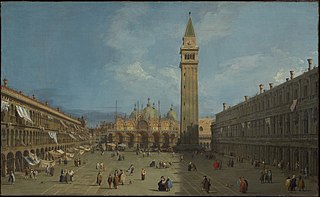
Piazza San Marco, often known in English as St Mark's Square, is the principal public square of Venice, Italy, where it is generally known just as la Piazza. Almost all the other urban spaces in the city are called campi ("fields"). The Piazzetta is an extension of the Piazza towards San Marco basin in its southeast corner. The two spaces together form the social, religious and political centre of Venice and are referred to together. This article relates to both of them.

The Doge's Palace is a palace built in Venetian Gothic style, and one of the main landmarks of the city of Venice in northern Italy. The palace was the residence of the Doge of Venice, the supreme authority of the former Republic of Venice. It was built in 1340 and extended and modified in the following centuries. It became a museum in 1923 and is one of the 11 museums run by the Fondazione Musei Civici di Venezia.

The Patriarchal Cathedral Basilica of Saint Mark, commonly known as St Mark's Basilica, is the cathedral church of the Patriarchate of Venice; it became the episcopal seat of the Patriarch of Venice in 1807, replacing the earlier cathedral of San Pietro di Castello. It is dedicated to and holds the relics of Saint Mark the Evangelist, the patron saint of the city.

The Grand Canal is a channel in Venice, Italy. It forms one of the major water-traffic corridors in the city.
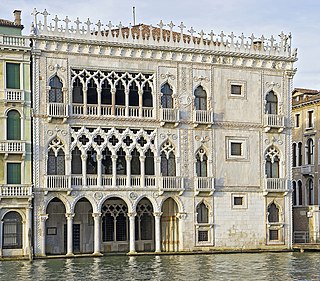
The Ca' d'Oro or Palazzo Santa Sofia is a palace on the Grand Canal in Venice, northern Italy. One of the older palaces in the city, its name means "golden house" due to the gilt and polychrome external decorations which once adorned its walls. Since 1927, it has been used as a museum, as the Galleria Giorgio Franchetti.

The Sunshine Building is a historic six-story building in downtown Albuquerque, New Mexico. It was built in 1924 by local theater owner Joseph Barnett and houses the Sunshine Theater as well as commercial space and offices. The Sunshine operated primarily as a movie theater until the 1980s, though it was also equipped for Vaudeville shows and other live performances. Since 1990 it has operated as a live music venue, hosting many notable acts. The building was listed on the New Mexico State Register of Cultural Properties in 1985 and is also an Albuquerque City Landmark.

The Old Albuquerque High School is the historic former campus of Albuquerque High School in Albuquerque, New Mexico. It is located in the Huning Highlands neighborhood and is protected by the city as a historic landmark. It is located on the northeast corner of Central and Broadway NE, at the center of an area that has become known as East Downtown or EDo. The campus comprises five buildings, the oldest of which was built in 1914. After the school moved to a new location in 1974, the old buildings were left abandoned for decades before being renovated as loft apartments in the early 21st century. Old Albuquerque High was added to the New Mexico State Register of Cultural Properties in 1977.
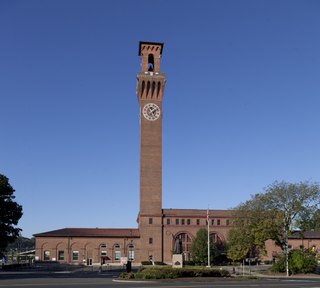
The Waterbury Union Station building is located on Meadow Street in the city of Waterbury, Connecticut, United States. It is a brick building dating to the first decade of the 20th century. Its tall clock tower, built by the Seth Thomas Company, is the city's most prominent landmark.

Venetian Gothic is the particular form of Italian Gothic architecture typical of Venice, originating in local building requirements, with some influence from Byzantine architecture, and some from Islamic architecture, reflecting Venice's trading network. Very unusually for medieval architecture, the style is both at its most characteristic in secular buildings, and the great majority of survivals are secular.

Gothic architecture appeared in the prosperous independent city-states of Italy in the 12th century, at the same time as it appeared in Northern Europe. In fact, unlike in other regions of Europe, it did not replace Romanesque architecture, and Italian architects were not very influenced by it. However, each city developed its own particular variations of the style. Italian architects preferred to keep the traditional construction methods established in the previous centuries; architectural solutions and technical innovations of French Gothic were seldom used. Soaring height was less important than in Northern Europe. Brick rather than stone was the most common building material, and marble was widely used for decoration. In the 15th century, when the Gothic style dominated both Northern Europe and the Italian Peninsula, Northern Italy became the birthplace of Renaissance architecture.

The First National Bank Building is a historic building in downtown Albuquerque, New Mexico, and the former headquarters of the First National Bank of Albuquerque. The nine-story building was completed in 1923 and was considered the city's first skyscraper with an overall height of 141 feet (43 m). It remained the tallest building in the city until 1954, when it was surpassed by the Simms Building.
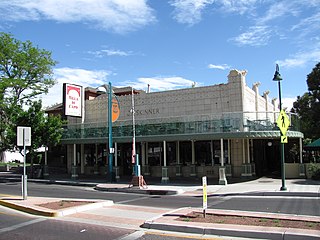
The Skinner Building is a historic building in Albuquerque, New Mexico, considered to be one of the best examples of Art Deco architecture in the city. Originally a grocery store owned by J.A. Skinner, it was designed by local architect A.W. Boehning and built in 1931. The building is of brick construction, with a street facade of white terra cotta tile on the north and west sides. Its exterior features a variety of decorative details including fluted towers, grill work, stained glass, and geometric patterns. The Skinner Building was added to the New Mexico State Register of Cultural Properties and the National Register of Historic Places in 1980.
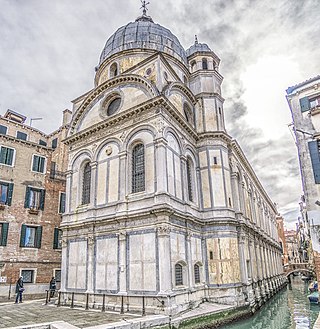
Venetian Renaissance architecture began rather later than in Florence, not really before the 1480s, and throughout the period mostly relied on architects imported from elsewhere in Italy. The city was very rich during the period, and prone to fires, so there was a large amount of building going on most of the time, and at least the facades of Venetian buildings were often particularly luxuriantly ornamented.

George Morrison Williamson was an American architect.

The Palazzo Pisani Gritti is a Venetian Gothic palazzo located on the north side of the Grand Canal, opposite the Church of the Salute, between the Campo del Traghetto and the Rio de l'Alboro, in the Sestieri of San Marco, Venice, Italy. It was the residence of Doge Andrea Gritti in the 16th century. It is now the Gritti Palace Hotel.

Main Building is the central administration building of St. Edward's University in Austin, Texas, and formerly also of St. Edward's High School. First completed in 1888 and rebuilt after a fire in 1903, Main Building has been listed on the National Register of Historic Places since 1973, along with adjacent Holy Cross Hall.
William Miles Brittelle was an American architect who practiced in Albuquerque, New Mexico, including with John J. Ginner as part of Brittelle & Ginner.

Palazzo Falier is a civil building located in Venice, Italy in the Cannaregio district. The palazzo is particularly known for having been the home of Marin Falier, Doge of the Republic of Venice, who was executed for attempting a coup d'état.

Palazzo Michiel del Brusà is a palace located in Venice, more precisely in the Cannaregio district, and overlooking the Grand Canal. The building is located between Palazzo Michiel dalle Colonne and Palazzo Smith Mangilli Valmarana.



















